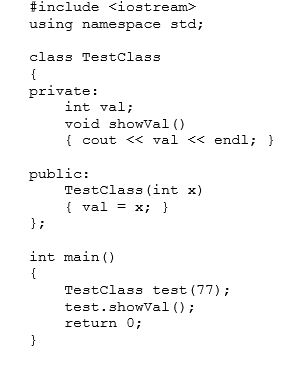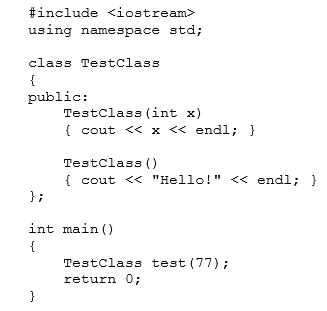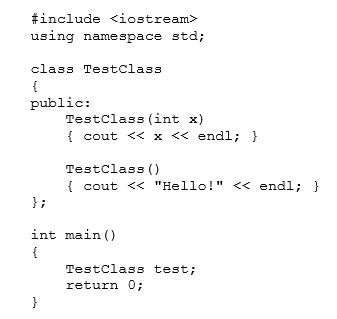Deck 13: Introduction to Classes
Question
Question
Question
Question
Question
Question
Question
Question
Question
Question
Question
Question
Question
Question
Question
Question
Question
Question
Question
Question
Question
Question
Question
Question
Question
Question
Question
Question
Question
Question
Question
Question
Question
Question
Question
Question
Question
Question
Question
Question
Question
Question
Question
Question
Question
Question
Question

Unlock Deck
Sign up to unlock the cards in this deck!
Unlock Deck
Unlock Deck
1/47
Play
Full screen (f)
Deck 13: Introduction to Classes
1
This type of member function may be called from a statement outside the class.
A)public
B)private
C)undeclared
D)global
E)None of these
A)public
B)private
C)undeclared
D)global
E)None of these
public
2
In a procedural program, you typically have ________ stored in a collection of variables, and a set of ________ that perform operations on the data.
A)numbers, arguments
B)parameters, arguments
C)strings, operators
D)data, functions
E)None of these
A)numbers, arguments
B)parameters, arguments
C)strings, operators
D)data, functions
E)None of these
data, functions
3
A ________ is a member function that is automatically called when a class object is ________.
A)destructor, created
B)constructor, created
C)static function, deallocated
D)utility function, declared
E)None of these
A)destructor, created
B)constructor, created
C)static function, deallocated
D)utility function, declared
E)None of these
constructor, created
4
Class declarations are usually stored here.
A)on separate disk volumes
B)in their own header files
C)in .cpp files, along with function definitions
D)under pseudonyms
E)None of these
A)on separate disk volumes
B)in their own header files
C)in .cpp files, along with function definitions
D)under pseudonyms
E)None of these

Unlock Deck
Unlock for access to all 47 flashcards in this deck.
Unlock Deck
k this deck
5
Examples of access specifiers are the key words:
A)near and far
B)opened and closed
C)private and public
D)table and row
E)None of these
A)near and far
B)opened and closed
C)private and public
D)table and row
E)None of these

Unlock Deck
Unlock for access to all 47 flashcards in this deck.
Unlock Deck
k this deck
6
This directive is used to create an "include guard," which allows a program to be conditionally compiled. This prevents a header file from accidentally being included more than once.
A)#include
B)#guard
C)#ifndef
D)#endif
E)None of these
A)#include
B)#guard
C)#ifndef
D)#endif
E)None of these

Unlock Deck
Unlock for access to all 47 flashcards in this deck.
Unlock Deck
k this deck
7
When a constructor function accepts no arguments, or does not have to accept arguments because of default arguments, it is called a(n)________.
A)empty constructor
B)default constructor
C)stand-alone function
D)arbitrator function
E)None of these
A)empty constructor
B)default constructor
C)stand-alone function
D)arbitrator function
E)None of these

Unlock Deck
Unlock for access to all 47 flashcards in this deck.
Unlock Deck
k this deck
8
A C++ class is similar to one of these.
A)inline function
B)header file
C)library function
D)structure
E)None of these
A)inline function
B)header file
C)library function
D)structure
E)None of these

Unlock Deck
Unlock for access to all 47 flashcards in this deck.
Unlock Deck
k this deck
9
When the body of a member function is defined inside a class declaration, it is said to be ________.
A)static
B)global
C)inline
D)conditional
E)None of these
A)static
B)global
C)inline
D)conditional
E)None of these

Unlock Deck
Unlock for access to all 47 flashcards in this deck.
Unlock Deck
k this deck
10
Objects are created from abstract data types that encapsulate ________ and ________ together.
A)numbers, characters
B)data, functions
C)addresses, pointers
D)integers, floats
E)None of these
A)numbers, characters
B)data, functions
C)addresses, pointers
D)integers, floats
E)None of these

Unlock Deck
Unlock for access to all 47 flashcards in this deck.
Unlock Deck
k this deck
11
If you do not declare an access specification, the default for members of a class is ________.
A)inline
B)private
C)public
D)global
E)None of these
A)inline
B)private
C)public
D)global
E)None of these

Unlock Deck
Unlock for access to all 47 flashcards in this deck.
Unlock Deck
k this deck
12
In OOP terminology, an object's member variables are often called its ________, and its member functions are sometimes referred to as its behaviors, or ________.
A)values, morals
B)data, activities
C)attributes, activities
D)attributes, methods
E)None of these
A)values, morals
B)data, activities
C)attributes, activities
D)attributes, methods
E)None of these

Unlock Deck
Unlock for access to all 47 flashcards in this deck.
Unlock Deck
k this deck
13
The destructor function's return type is ________.
A)tilde
B)int
C)float
D)Nothing. Destructors have no return type.
E)None of the above
A)tilde
B)int
C)float
D)Nothing. Destructors have no return type.
E)None of the above

Unlock Deck
Unlock for access to all 47 flashcards in this deck.
Unlock Deck
k this deck
14
The constructor function's return type is ________.
A)int
B)float
C)char
D)structure pointer
E)None of these
A)int
B)float
C)char
D)structure pointer
E)None of these

Unlock Deck
Unlock for access to all 47 flashcards in this deck.
Unlock Deck
k this deck
15
When you dereference an object pointer, use the ________.
A)-> operator
B)<> operator
C)dot operator
D)& operator
E)None of these
A)-> operator
B)<> operator
C)dot operator
D)& operator
E)None of these

Unlock Deck
Unlock for access to all 47 flashcards in this deck.
Unlock Deck
k this deck
16
Assuming that Rectangle is a class name, the statement: 
A)declares an object of class Rectangle
B)assigns the value of *BoxPtr to the object Rectangle
C)defines a Rectangle pointer variable called BoxPtr
D)is illegal in C++
E)None of these

A)declares an object of class Rectangle
B)assigns the value of *BoxPtr to the object Rectangle
C)defines a Rectangle pointer variable called BoxPtr
D)is illegal in C++
E)None of these

Unlock Deck
Unlock for access to all 47 flashcards in this deck.
Unlock Deck
k this deck
17
A class is a(n)________ that is defined by the programmer.
A)data type
B)function
C)method
D)attribute
E)None of these
A)data type
B)function
C)method
D)attribute
E)None of these

Unlock Deck
Unlock for access to all 47 flashcards in this deck.
Unlock Deck
k this deck
18
Members of a class object are accessed with the ________.
A)dot operator
B)cin object
C)extraction operator
D)stream insertion operator
E)None of these
A)dot operator
B)cin object
C)extraction operator
D)stream insertion operator
E)None of these

Unlock Deck
Unlock for access to all 47 flashcards in this deck.
Unlock Deck
k this deck
19
This is used to protect important data.
A)public access specifier
B)private access specifier
C)protect()member function
D)class protection operator, @
E)None of these
A)public access specifier
B)private access specifier
C)protect()member function
D)class protection operator, @
E)None of these

Unlock Deck
Unlock for access to all 47 flashcards in this deck.
Unlock Deck
k this deck
20
This type of member function may be called only from a function that is a member of the same class.
A)public
B)private
C)global
D)local
E)None of these
A)public
B)private
C)global
D)local
E)None of these

Unlock Deck
Unlock for access to all 47 flashcards in this deck.
Unlock Deck
k this deck
21
A class may have this many default constructor(s).
A)only one
B)more than one
C)a maximum of two
D)any number
E)None of these
A)only one
B)more than one
C)a maximum of two
D)any number
E)None of these

Unlock Deck
Unlock for access to all 47 flashcards in this deck.
Unlock Deck
k this deck
22
What is the output of the following program?

A)The program runs, but with no output.
B)77
C)0
D)The program will not compile.

A)The program runs, but with no output.
B)77
C)0
D)The program will not compile.

Unlock Deck
Unlock for access to all 47 flashcards in this deck.
Unlock Deck
k this deck
23
This is automatically called when an object is destroyed.
A)constructor function
B)specification deallocator
C)destructor function
D)coroner function
E)None of these
A)constructor function
B)specification deallocator
C)destructor function
D)coroner function
E)None of these

Unlock Deck
Unlock for access to all 47 flashcards in this deck.
Unlock Deck
k this deck
24
The constructor function may not accept arguments.

Unlock Deck
Unlock for access to all 47 flashcards in this deck.
Unlock Deck
k this deck
25
You must declare all data members of a class before you declare member functions.

Unlock Deck
Unlock for access to all 47 flashcards in this deck.
Unlock Deck
k this deck
26
What is the output of the following program?

A)The program runs, but with no output.
B)77
C)Hello!
D)The program will not compile.

A)The program runs, but with no output.
B)77
C)Hello!
D)The program will not compile.

Unlock Deck
Unlock for access to all 47 flashcards in this deck.
Unlock Deck
k this deck
27
If a local variable and a global variable have the same name within the same program, the ________ resolution operator must be used.
A)variable
B)ambiguity
C)scope
D)global
E)None of these
A)variable
B)ambiguity
C)scope
D)global
E)None of these

Unlock Deck
Unlock for access to all 47 flashcards in this deck.
Unlock Deck
k this deck
28
More than one destructor function may be defined for a class.

Unlock Deck
Unlock for access to all 47 flashcards in this deck.
Unlock Deck
k this deck
29
Assume that myCar is an instance of the Car class, and that the Car class has a member function named accelerate. Which of the following is a valid call to the accelerate member function?
A)Car->accelerate();
B)myCar::accelerate();
C)myCar.accelerate();
D)myCar:accelerate();
A)Car->accelerate();
B)myCar::accelerate();
C)myCar.accelerate();
D)myCar:accelerate();

Unlock Deck
Unlock for access to all 47 flashcards in this deck.
Unlock Deck
k this deck
30
Class objects can be defined prior to the class declaration.

Unlock Deck
Unlock for access to all 47 flashcards in this deck.
Unlock Deck
k this deck
31
The process of object-oriented analysis can be viewed as the following steps:
A)Identify objects, then define objects' attributes, behaviors, and relationships
B)Define data members and member functions, then assign a class name
C)Declare private and public variables, prototype functions, then write code
D)Write the main()function, then determine which classes are needed
E)None of these
A)Identify objects, then define objects' attributes, behaviors, and relationships
B)Define data members and member functions, then assign a class name
C)Declare private and public variables, prototype functions, then write code
D)Write the main()function, then determine which classes are needed
E)None of these

Unlock Deck
Unlock for access to all 47 flashcards in this deck.
Unlock Deck
k this deck
32
When a member function is defined outside of the class declaration, the function name must be qualified with the ________.
A)class name, followed by a semicolon
B)class name, followed by the scope resolution operator
C)name of the first object
D)private access specifier
E)None of these
A)class name, followed by a semicolon
B)class name, followed by the scope resolution operator
C)name of the first object
D)private access specifier
E)None of these

Unlock Deck
Unlock for access to all 47 flashcards in this deck.
Unlock Deck
k this deck
33
More than one constructor function may be defined for a class.

Unlock Deck
Unlock for access to all 47 flashcards in this deck.
Unlock Deck
k this deck
34
For the following code, which statement is not true?

A)x is available to code that is written outside the class.
B)The name of the class is Point.
C)x, y, and z are called members of the class.
D)z is available to code that is written outside the class.

A)x is available to code that is written outside the class.
B)The name of the class is Point.
C)x, y, and z are called members of the class.
D)z is available to code that is written outside the class.

Unlock Deck
Unlock for access to all 47 flashcards in this deck.
Unlock Deck
k this deck
35
Objects in an array are accessed with ________, just like any other data type in an array.
A)subscripts
B)parentheses
C)#include statements
D)output format manipulators
E)None of these
A)subscripts
B)parentheses
C)#include statements
D)output format manipulators
E)None of these

Unlock Deck
Unlock for access to all 47 flashcards in this deck.
Unlock Deck
k this deck
36
What is the output of the following program?

A)The program runs, but with no output.
B)0
C)Hello!
D)The program will not compile.

A)The program runs, but with no output.
B)0
C)Hello!
D)The program will not compile.

Unlock Deck
Unlock for access to all 47 flashcards in this deck.
Unlock Deck
k this deck
37
Whereas object-oriented programming centers on the object, procedural programming centers on functions.

Unlock Deck
Unlock for access to all 47 flashcards in this deck.
Unlock Deck
k this deck
38
The constructor function always has the same name as ________.
A)the first private data member
B)the first public data member
C)the class
D)the first object of the class
E)None of these
A)the first private data member
B)the first public data member
C)the class
D)the first object of the class
E)None of these

Unlock Deck
Unlock for access to all 47 flashcards in this deck.
Unlock Deck
k this deck
39
Object-oriented programming is centered around the object, which encapsulate together both the data and the functions that operate on the data.

Unlock Deck
Unlock for access to all 47 flashcards in this deck.
Unlock Deck
k this deck
40
A destructor function can have zero to many parameters.

Unlock Deck
Unlock for access to all 47 flashcards in this deck.
Unlock Deck
k this deck
41
You must use the private access specification for all data members of a class.

Unlock Deck
Unlock for access to all 47 flashcards in this deck.
Unlock Deck
k this deck
42
One purpose that constructor functions are often used for is to allocate memory that will be needed by the object.

Unlock Deck
Unlock for access to all 47 flashcards in this deck.
Unlock Deck
k this deck
43
One purpose that destructor functions are often used for is to free memory that was allocated by the object.

Unlock Deck
Unlock for access to all 47 flashcards in this deck.
Unlock Deck
k this deck
44
When using smart pointers to dynamically allocate objects in C++ 11, it is unnecessary to delete the dynamically allocated objects because the smart pointer will automatically delete them.

Unlock Deck
Unlock for access to all 47 flashcards in this deck.
Unlock Deck
k this deck
45
A private member function is useful for tasks that are internal to the class, but is not directly called by statements outside the class.

Unlock Deck
Unlock for access to all 47 flashcards in this deck.
Unlock Deck
k this deck
46
When an object is defined without an argument list for its constructor, the compiler automatically calls the object's default constructor.

Unlock Deck
Unlock for access to all 47 flashcards in this deck.
Unlock Deck
k this deck
47
If you do not declare a destructor function, the compiler will furnish one automatically.

Unlock Deck
Unlock for access to all 47 flashcards in this deck.
Unlock Deck
k this deck



